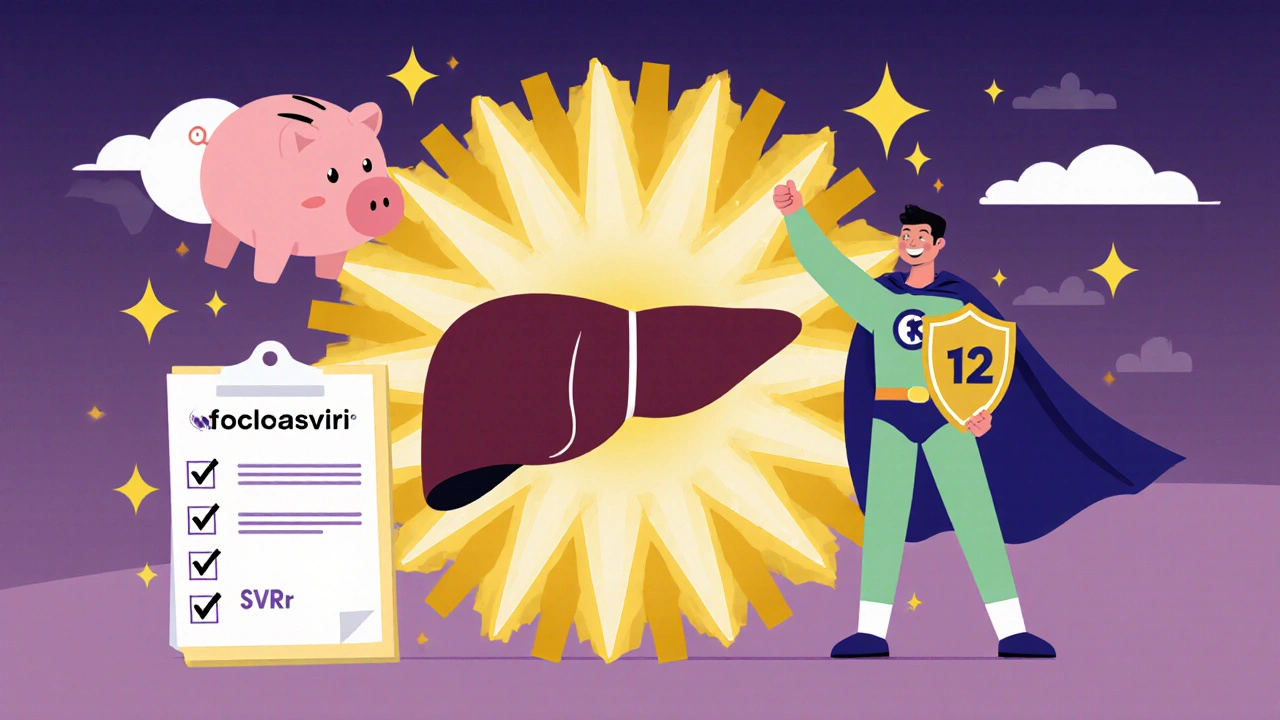
Daclatasvir Dosage Calculator
Treatment Calculator
Your Treatment Plan
Key Takeaways
- daclatasvir is an NS5A inhibitor used in combination regimens to cure hepatitis C.
- It works against multiple genotypes, but dosing varies by genotype and co‑medications.
- Common side effects are mild; serious events are rare but require monitoring.
- Cost depends on insurance, country, and treatment length; patient assistance programs exist.
- Always follow a physician’s guidance and get baseline labs before starting.
What Is Daclatasvir?
Daclatasvir is an oral antiviral medication that targets the NS5A protein of hepatitis C virus (HCV), blocking viral replication and helping clear the infection when used with other direct‑acting antivirals. First approved by the FDA in 2015, it quickly became part of several all‑oral regimens that eliminated the need for interferon.
How Does Daclatasvir Fit Into Hepatitis C Treatment?
Hepatitis C is a liver infection caused by the hepatitis C virus, classified into seven genotypes (1‑7) that differ in geographic spread and treatment response. Daclatasvir belongs to the NS5A inhibitor class, alongside drugs like Ledipasvir and Ombitasvir. By binding to NS5A, it disrupts the formation of the viral replication complex, making the virus vulnerable to other agents such as the nucleoside polymerase inhibitor Sofosbuvir.
When Is Daclatasvir Prescribed?
- Genotype 1, 2, 3, 4, or 5 infections when combined with Sofosbuvir (with or without Ribavirin).
- Patients who cannot tolerate interferon‑based regimens.
- Cases where resistance‑associated substitutions (RAS) to other NS5A inhibitors are present.
Its flexibility makes it a go‑to option for patients with chronic kidney disease or advanced liver disease, as the drug is primarily metabolized by the liver and requires no dose adjustment for renal impairment.
Typical Dosage and Treatment Length
- Standard adult dose: 60mg (one tablet) taken orally once daily.
- If combined with Sofosbuvir+Ribavirin for genotype 3, the course is usually 12weeks.
- For genotype 1 or 4 without Ribavirin, 12weeks of Daclatasvir+Sofosbuvir is common.
- Patients with cirrhosis may require 24weeks depending on prior treatment history.
Always follow the prescribing physician’s schedule; missing doses can lead to viral breakthrough and resistance.
Potential Side Effects
Most users experience mild, transient symptoms. The most frequently reported events (≥10%) include:
- Fatigue
- Headache
- Nausea
- Diarrhea
Serious adverse events are uncommon but may involve:
- Elevated liver enzymes (ALT/AST)
- QT‑interval prolongation (especially when taken with certain anti‑arrhythmics)
- Severe anemia when ribavirin is co‑administered.
Patients should have baseline liver function tests and periodic monitoring during therapy. If ALT rises more than five times the upper limit of normal, the clinician may pause or adjust treatment.
Drug Interactions You Should Know
Daclatasvir is a substrate of CYP3A4 and P‑gp transporters. Significant interactions include:
| Interacting Agent | Effect on Daclatasvir | Clinical Action |
|---|---|---|
| Strong CYP3A4 inducers (e.g., rifampin, carbamazepine) | Decreases exposure by ~80% | Avoid co‑administration or increase dose under specialist guidance |
| Strong CYP3A4 inhibitors (e.g., ketoconazole, lopinavir/ritonavir) | Increases exposure by ~1.9‑fold | Reduce Daclatasvir dose to 30mg daily |
| Antacids (aluminum‑ or magnesium‑based) | May reduce absorption | Separate intake by at least 2hours |
| Amiodarone or other QT‑prolonging drugs | Potential additive cardiac risk | Electrocardiogram monitoring; consider alternatives |
Always provide a complete medication list to the prescribing clinician.

Cost, Insurance, and Patient Assistance
In the United States, a 12‑week course of Daclatasvir+Sofosbuvir (brand name Harvoni‑like regimens) averages $30,000‑$45,000 before insurance. Prices vary by pharmacy and whether generic versions are available. Many insurers cover the drug under specialty pharmacy benefits, but prior authorization is typical.
The WHO recommends that treatment be made affordable worldwide; several global programs provide the medication at reduced cost in low‑income countries.
Patients can apply for manufacturer‑sponsored assistance programs, which may cover up to 100% of the out‑of‑pocket expense for eligible individuals.
Monitoring and Follow‑Up
Effective therapy is measured by sustained virologic response (SVR) 12 weeks after treatment ends (SVR12). The steps are:
- Baseline HCV RNA quantitative PCR.
- Mid‑treatment HCV RNA check at week 4 (optional, but useful for high‑risk patients).
- End‑of‑treatment HCV RNA test.
- SVR12 test to confirm cure.
If SVR12 is achieved, the virus is considered cleared in >95% of cases. Relapse is rare but may occur in patients with advanced cirrhosis or poor adherence.
Frequently Asked Questions
Can I take Daclatasvir if I am pregnant?
Current data are limited, and the drug is classified as Pregnancy Category C. The benefits must outweigh potential risks, so it is only prescribed if no safer alternative exists.
Do I need to fast before taking Daclatasvir?
No fasting is required. The tablet can be taken with or without food.
What happens if I miss a dose?
Take the missed dose as soon as you remember, unless it is within 12hours of the next scheduled dose. In that case, skip the missed one and resume the regular schedule. Do not double‑dose.
Can Daclatasvir cure all hepatitis C genotypes?
When paired with appropriate companions (usually Sofosbuvir), it is effective against genotypes 1‑4 and 6. Genotype 5 and some subtype‑3 infections may need longer treatment or additional ribavirin.
Is there a generic version of Daclatasvir?
Yes, generic tablets have been approved in several countries (e.g., India, Egypt). In the U.S., the brand name is still dominant, but insurance plans may source generics when available.
Bottom Line
Daclatasvir remains a cornerstone of modern hepatitis C therapy thanks to its high barrier to resistance, once‑daily dosing, and compatibility with multiple genotype regimens. Proper patient selection, awareness of drug interactions, and diligent monitoring are the keys to achieving cure while minimizing side effects and cost burdens.
Comments (9)
-
Mary Davies October 17, 2025
I've been digging into the data on daclatasvir and, wow, the way it tackles multiple genotypes is pretty impressive. The fact that it bypasses the need for interferon really changes the game for patients who can’t tolerate those harsh side effects. Still, the interaction with strong CYP3A4 inducers worries me – you really have to double‑check every prescription list. And while the cost looks steep, those patient assistance programs can be a lifesaver if you navigate the paperwork early. Bottom line: a solid option, but it demands careful monitoring and a proactive approach from both doctor and patient.
-
Emily (Emma) Majerus October 19, 2025
Sounds solid, just double‑check your meds with your doc!
-
Virginia Dominguez Gonzales October 20, 2025
Absolutely, the regimen’s simplicity-once‑daily dosing with food or not-makes adherence way easier for folks battling chronic liver disease. Remember to schedule those baseline labs; catching a spike in ALT early can prevent bigger setbacks. If you’re on a strong CYP3A4 inducer, the dose tweak is crucial, otherwise the virus could slip through the cracks. And don’t forget the emotional boost that comes with knowing a cure is within reach-many patients report a huge lift in morale once they start treatment. Keep the communication open with your healthcare team; they’ll adjust the plan if any side effects pop up.
-
Richard O'Callaghan October 22, 2025
Yo, I gotta ask-did u tell ur doc about that rifampin thing? If not, you might be losin the whole thing ‘cause the drug gets yanked out fast. Also, make sure u ain’t takin any antacids at the same time, cause that can mess up absorption big time. That’s why i always keep a list of everything i’m on, you know? Don't let some random pharm miss it.
-
Kevin Adams October 23, 2025
Daclatasvir sits at the crossroads of chemistry and hope. It whispers to the virus that the days of replication are over. In the theater of medicine it plays the lead role beside Sofosbuvir. The script demands strict timing and respect for the enzymes that shape its destiny. Miss a dose and the plot twists toward resistance. Patients who trust the regimen become protagonists in their own cure story. The cost may tower like a wall but assistance programs are the hidden doors. Genotype 3 patients find themselves on a longer stage but the applause at SVR12 is worth the wait. The side effects are a chorus of mild notes that fade fast. Serious adverse events are rare yet they remind us that every drug carries a shadow. Monitoring liver enzymes is the backstage crew keeping the performance smooth. Interaction with strong CYP3A4 inducers is a plot twist that can silence the hero. Reduce the dose when inhibitors appear and the balance is restored. The journey from baseline to cured is a pilgrimage through labs and appointments. When the final test shows no virus the curtain falls and the audience erupts. This saga proves that science can write happy endings.
-
Sara Werb October 25, 2025
Wow!!! This drug sounds like a miracle but have you ever wondered why the big pharma giants push such sky‑high prices??? They want us all in debt while they line their pockets with our health!!! The assistance programs are just a PR stunt to keep us buying their brand names instead of the cheap generics that could be made in any lab!!! And don't even start on the hidden clauses in the consent forms that let them track our DNA!!! It's a battle out there and we need to stay vigilant!!!
-
Winston Bar October 26, 2025
Sure, it's all hype and glossy brochures. I don't see the point in spending that much on a pill when lifestyle changes could do the trick.
-
Russell Abelido October 27, 2025
Hey, I get where you're coming from, but think of it this way-if a pill can give someone back years of healthy life, isn't that worth something? 🤔 It's not just about the drug; it's about giving people hope and a future to look forward to.
-
Steve Holmes October 29, 2025
Exactly!!! Maybe we can all agree that combining medical advances with patient education is the smartest move forward!!! Let's keep sharing resources and making sure everyone gets the support they need!!!
